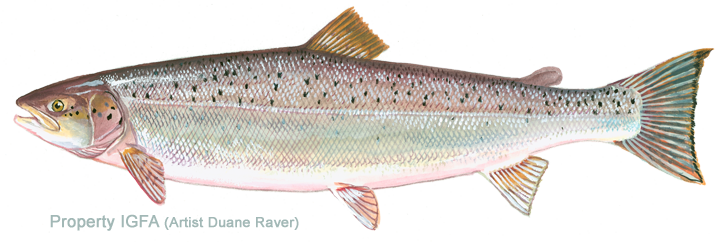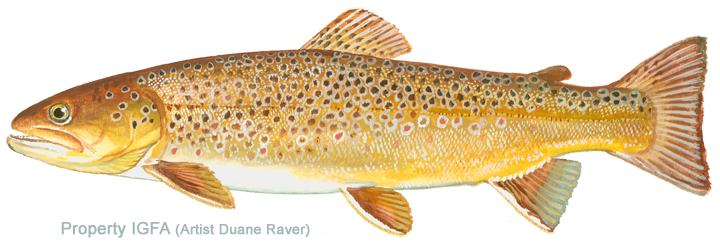Game Fish Identification Reference Guides
Salmon, Atlantic (landlocked)
(Salmo salar)
(Salmo salar)

Linnaeus, 1758; SALMONIDAE FAMILY; also called landlocked salmon, ouananiche, Kennebec salmon, Sebago salmon, black salmon, grilse, kelt, grayling, smolt, parr, slink
The Atlantic salmon is native to the northern Atlantic from the Connecticut River to Quebec, Iceland and southern Greenland. It also occurs from the Arctic Circle to Portugal. Inland, there are a number of landlocked populations that must be considered strictly freshwater fish. Otherwise, the species is anadromous (migrates to the sea and back, and spawns in fresh water). Unlike Pacific salmons (Oncorhynchus spp.), Atlantic salmon spawn more than once before dying.
It has the body shape of a trout, and is distinguished from trouts of the genus Oncorhynthus by coloration, size, and location of occurrence, among other things. At sea it is a silvery fish with a sparse scattering of small black spots often shaped like X's or Y's on the upper half of the body, and sometimes with a few spots on the cheek and gill cover. In inland waters, especially at spawning time, the Atlantic salmon turns a much darker color of bronze or dark brown. This change may be accompanied by the appearance of red spots on the head and body, making this fish look remarkably like a brown trout (Salmo trutta), its closest relative. Often brown trout may have circles, or halos, around some of its spots and the spotting may be heavier than in the Atlantic salmon, extending onto the lower half of the sides and the fins including the adipose fin. The spots do not normally take the form of X's or Y's.
The value of the Atlantic salmon both as a sports fish and as a commercial and food fish cannot be exaggerated.
The Atlantic salmon is native to the northern Atlantic from the Connecticut River to Quebec, Iceland and southern Greenland. It also occurs from the Arctic Circle to Portugal. Inland, there are a number of landlocked populations that must be considered strictly freshwater fish. Otherwise, the species is anadromous (migrates to the sea and back, and spawns in fresh water). Unlike Pacific salmons (Oncorhynchus spp.), Atlantic salmon spawn more than once before dying.
It has the body shape of a trout, and is distinguished from trouts of the genus Oncorhynthus by coloration, size, and location of occurrence, among other things. At sea it is a silvery fish with a sparse scattering of small black spots often shaped like X's or Y's on the upper half of the body, and sometimes with a few spots on the cheek and gill cover. In inland waters, especially at spawning time, the Atlantic salmon turns a much darker color of bronze or dark brown. This change may be accompanied by the appearance of red spots on the head and body, making this fish look remarkably like a brown trout (Salmo trutta), its closest relative. Often brown trout may have circles, or halos, around some of its spots and the spotting may be heavier than in the Atlantic salmon, extending onto the lower half of the sides and the fins including the adipose fin. The spots do not normally take the form of X's or Y's.
The value of the Atlantic salmon both as a sports fish and as a commercial and food fish cannot be exaggerated.













